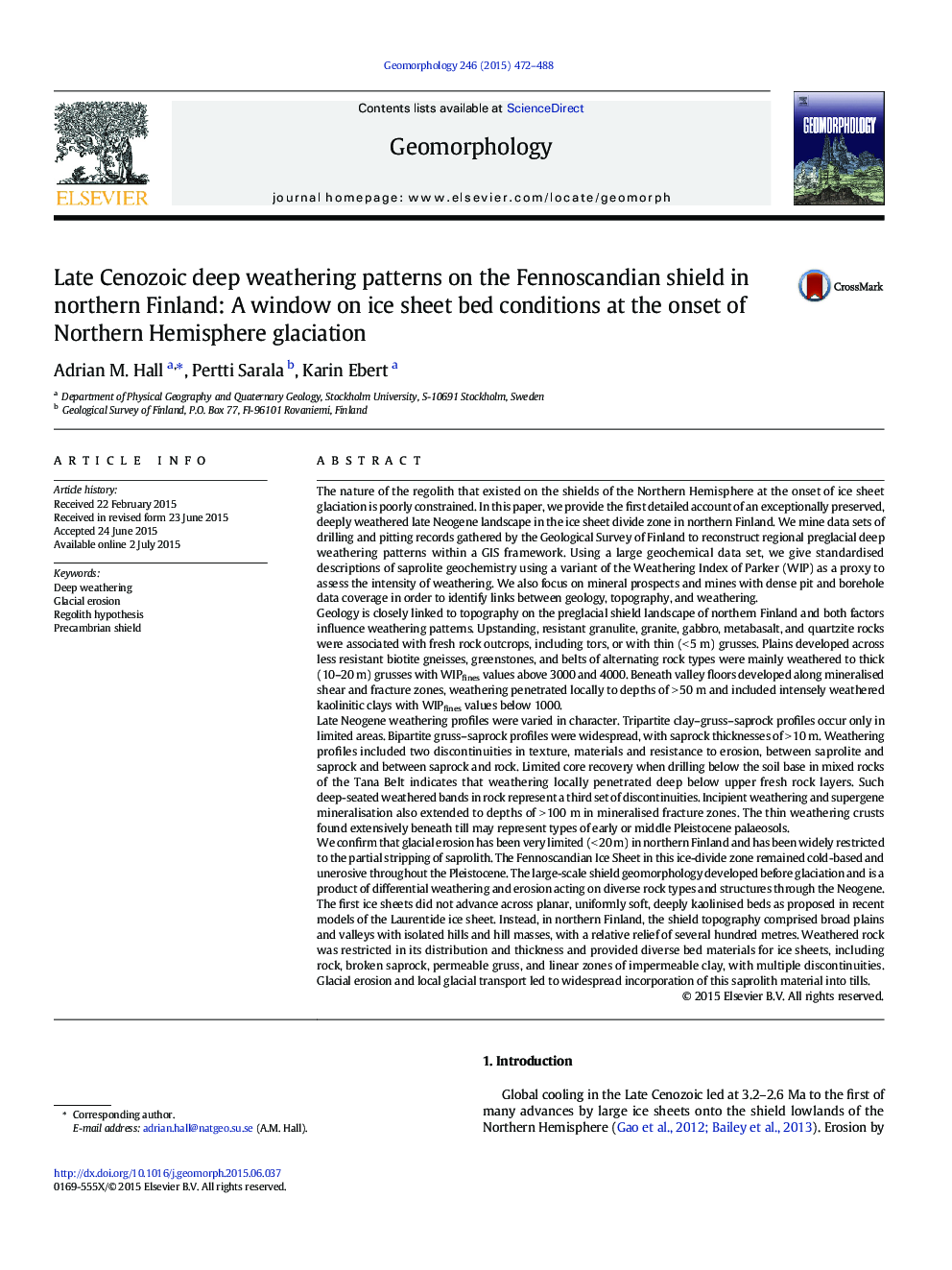| Article ID | Journal | Published Year | Pages | File Type |
|---|---|---|---|---|
| 6431982 | Geomorphology | 2015 | 17 Pages |
â¢Exceptional preservation of a Neogene deeply weathered shield landscape in northern Finland.â¢Gruss-type weathering dominant, with narrow zones of kaolinisationâ¢First late Cenozoic ice sheets did not advance across planar, deeply kaolinised beds.â¢Ice sheet erosion unable to remove saprolite
The nature of the regolith that existed on the shields of the Northern Hemisphere at the onset of ice sheet glaciation is poorly constrained. In this paper, we provide the first detailed account of an exceptionally preserved, deeply weathered late Neogene landscape in the ice sheet divide zone in northern Finland. We mine data sets of drilling and pitting records gathered by the Geological Survey of Finland to reconstruct regional preglacial deep weathering patterns within a GIS framework. Using a large geochemical data set, we give standardised descriptions of saprolite geochemistry using a variant of the Weathering Index of Parker (WIP) as a proxy to assess the intensity of weathering. We also focus on mineral prospects and mines with dense pit and borehole data coverage in order to identify links between geology, topography, and weathering.Geology is closely linked to topography on the preglacial shield landscape of northern Finland and both factors influence weathering patterns. Upstanding, resistant granulite, granite, gabbro, metabasalt, and quartzite rocks were associated with fresh rock outcrops, including tors, or with thin (<Â 5Â m) grusses. Plains developed across less resistant biotite gneisses, greenstones, and belts of alternating rock types were mainly weathered to thick (10-20Â m) grusses with WIPfines values above 3000 and 4000. Beneath valley floors developed along mineralised shear and fracture zones, weathering penetrated locally to depths of >Â 50Â m and included intensely weathered kaolinitic clays with WIPfines values below 1000.Late Neogene weathering profiles were varied in character. Tripartite clay-gruss-saprock profiles occur only in limited areas. Bipartite gruss-saprock profiles were widespread, with saprock thicknesses of >Â 10Â m. Weathering profiles included two discontinuities in texture, materials and resistance to erosion, between saprolite and saprock and between saprock and rock. Limited core recovery when drilling below the soil base in mixed rocks of the Tana Belt indicates that weathering locally penetrated deep below upper fresh rock layers. Such deep-seated weathered bands in rock represent a third set of discontinuities. Incipient weathering and supergene mineralisation also extended to depths of >Â 100Â m in mineralised fracture zones. The thin weathering crusts found extensively beneath till may represent types of early or middle Pleistocene palaeosols.We confirm that glacial erosion has been very limited (<Â 20Â m) in northern Finland and has been widely restricted to the partial stripping of saprolith. The Fennoscandian Ice Sheet in this ice-divide zone remained cold-based and unerosive throughout the Pleistocene. The large-scale shield geomorphology developed before glaciation and is a product of differential weathering and erosion acting on diverse rock types and structures through the Neogene. The first ice sheets did not advance across planar, uniformly soft, deeply kaolinised beds as proposed in recent models of the Laurentide ice sheet. Instead, in northern Finland, the shield topography comprised broad plains and valleys with isolated hills and hill masses, with a relative relief of several hundred metres. Weathered rock was restricted in its distribution and thickness and provided diverse bed materials for ice sheets, including rock, broken saprock, permeable gruss, and linear zones of impermeable clay, with multiple discontinuities. Glacial erosion and local glacial transport led to widespread incorporation of this saprolith material into tills.
